Sandra Naumann – Ludwig Boltzmann Institute Media.Art.Research, Linz, Austria
Seeing Sound: Mary Ellen Bute’s Short Films
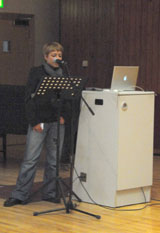 From the turn of the 19th century music has served as a paradigm for the non-mimetic presentation and the exploration of temporal structures and harmonic connections in the visual arts, first in abstract painting and since the 1920’s in the absolute film. Mary Ellen Bute, who started out with abstract painting and experimenting with light, was a pioneer of abstract film in the USA, and among the first filmmakers to explore the possibilities of electronic sound-image transformation. Between the 1930’s and the mid-1950’s she produced a series of photographic and animated short films under the title “Seeing Sound”, wherein she transferred principles of musical composition to the organization of visual materials and applied various ways of linking sound and image. In the paper I will explore her concepts and methods to create Visual Music and relate them to contemporary practices like VJing and audiovisual live performances.
From the turn of the 19th century music has served as a paradigm for the non-mimetic presentation and the exploration of temporal structures and harmonic connections in the visual arts, first in abstract painting and since the 1920’s in the absolute film. Mary Ellen Bute, who started out with abstract painting and experimenting with light, was a pioneer of abstract film in the USA, and among the first filmmakers to explore the possibilities of electronic sound-image transformation. Between the 1930’s and the mid-1950’s she produced a series of photographic and animated short films under the title “Seeing Sound”, wherein she transferred principles of musical composition to the organization of visual materials and applied various ways of linking sound and image. In the paper I will explore her concepts and methods to create Visual Music and relate them to contemporary practices like VJing and audiovisual live performances.
Sandra’s talk was based in part on a longer article that has recently been published: Naumann, Sandra. “Seeing Sound: The Short Films of Mary Ellen Bute.” In Audio • Visual – on Visual Music and Related Media, edited by Cornelia Lund and Holger Lund, 40-54. Stuttgart: Arnoldsche 2008.
Biography: Sandra Naumann (born 1976 in Leipzig, DE) is a researcher at the Ludwig Boltzmann Institute Media.Art.Research. in Linz (AT), where she works on a exhibition, research and mediation project on the relation of image and sound in art, media and perception, both present and past. She studied Communication and Media Sciences, Art History and German Literature at the University of Leipzig and the University of Manchester, writing her M.A. thesis about Mary Ellen Bute and Visual Music. Her previous occupations embrace repertory cinema, film distribution, film production and film festivals. Her other topics of interest are Avant-garde and experimental film as well as audiovisual live performances.
Sandra has recently been heavily involved in the (highly recommended) See This Sound event in Linz, Austria
Jon Pigott – University of Wales Institute, Cardiff
Visual Speakers: Prepared Loudspeakers with a Visual Theme
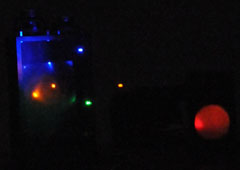 Much of my recent work has involved ‘prepared speakers’ – loudspeakers that have been physically altered in some way to change their sonic characteristics. The work concerns the interaction between the physical and electromagnetic sound worlds and explores the defining of the loudspeaker as a source rather than a carrier of sound. The visual speakers form part of the trajectory of this work but are also indebted to practitioners such as Thomas Wilfred who were working with mechanical and early electrical technologies to produce Lumia in the early twentieth century. As part of the presentation I will also attempt, for the first time outside of my kitchen, to demonstrate the non-Newtonian nature of oobleck on a speaker cone -binoculars and chemistry lab goggles may be necessary…
Much of my recent work has involved ‘prepared speakers’ – loudspeakers that have been physically altered in some way to change their sonic characteristics. The work concerns the interaction between the physical and electromagnetic sound worlds and explores the defining of the loudspeaker as a source rather than a carrier of sound. The visual speakers form part of the trajectory of this work but are also indebted to practitioners such as Thomas Wilfred who were working with mechanical and early electrical technologies to produce Lumia in the early twentieth century. As part of the presentation I will also attempt, for the first time outside of my kitchen, to demonstrate the non-Newtonian nature of oobleck on a speaker cone -binoculars and chemistry lab goggles may be necessary…
Jon promises to have some documentation of his visual speakers online soon!
Biography: Jon is a sonic artist, researcher, musician and lecturer in Music Production Technology at Cardiff School of Art and Design (UWIC). Prior to this he worked at Peter Gabriel’s Real World Studios for nine years where he headed up the technical team, wrestled with wires, tussled with transistors and helped to bring countless high profile music and film productions to fruition. In 2007 Jon was awarded his MA in Creative Music Technology at Bath Spa University. In the same year he exhibited the worlds first ‘Sonic Marble Run’ at the Sonic Arts Expo in Plymouth as well as in his hometown of Bristol. Jon has also exhibited and presented his work in Norway (Norsk Kultur Rad: 1998, WRAP: 2005), Southampton (Millais Gallery 2007), WookeyHole Caves, Somerset (2004) and Newport (WIRAD 2009). sonicmarbles.co.uk
Prof. Rajmil Fischman, Dr Diego Garro, Steve Bird, Andy Willy, Joseph Harrison –
University of Keele
Research in AudioVisual composition at Keele University
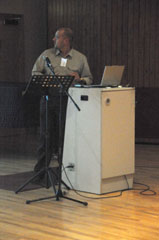 Composers/researchers from Keele University will outline their respective approaches to the composition in the audio-video combined media, establishing links between their recent production and their personal and academic backgrounds in Electroacoustic and Visual arts.
Composers/researchers from Keele University will outline their respective approaches to the composition in the audio-video combined media, establishing links between their recent production and their personal and academic backgrounds in Electroacoustic and Visual arts.
A pdf of Diego’s powerpoint slides can be seen here
Biographies for these delegates can be found in the ‘Screenings’ section
Dr Bret Battey – DeMontfort University
Archetypes of Dissolution: the Luna Series
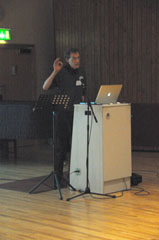 The “Luna Series” is comprised of three audio-visual works composed by Battey between 2007 and 2009. They share core aesthetic concerns, includingan approach to sound and image relationship that Battey calls “isomorphism of complex gestalts.” They also entail a common set of custom technological approaches which lend themselves to this aesthetic approach: Compressed Feedback Synthesis and the Brownian Doughnut Warper filter algorithm for image.
The “Luna Series” is comprised of three audio-visual works composed by Battey between 2007 and 2009. They share core aesthetic concerns, includingan approach to sound and image relationship that Battey calls “isomorphism of complex gestalts.” They also entail a common set of custom technological approaches which lend themselves to this aesthetic approach: Compressed Feedback Synthesis and the Brownian Doughnut Warper filter algorithm for image.
A pdf of Bret’s powerpoint slides can be seen here
Biography: Bret Battey (b. 1967) creates electronic, acoustic, and multimedia concert works and installations, synthesizing a diverse professional and educational background in music composition, computer programming, graphic and web design, and electronics. He has been a Fulbright Fellow to India and a MacDowell Colony Fellow, and he has received recognitions and prizes from Austria’s Prix Ars Electronica, France’s Bourges Concours International de Musique Electroacoustique, Spain’s Punto y Raya Festival, Abstracta Cinema of Rome, and Amsterdam Film eXperience for his sound and image compositions. He pursues research in areas related to algorithmic music, digital signal processing, image and sound relationship, and expressive synthesis, with papers published in Computer Music Journal and Organized Sound. He completed his masters and doctoral studies in Music Composition at the University of Washington and his Bachelors of Music in Electronic and Computer Music at Oberlin Conservatory. His primary composition and technology teachers have been Conrad Cummings, Richard Karpen, and Gary Nelson. He also served as a Research Associate for the University of Washington’s Center for Digital Arts and Experimental Media. He is a Senior Lecturer with the Music, Technology, and Innovation Research Centre at De Montfort University, Leicester, UK.
www.BatHatMedia.com
Dr Mick Grierson -Goldsmiths College
Lumisonic on the iPhone: Real-time Mobile FFTs and visualisation.
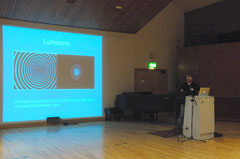 In 2008 Mick Grierson collaborated with the Sonic Arts Network to create “LumiSonic”, a freely available interactive audiovisual music interface for the deaf and hard of hearing. Following its success and impact in both the academic arena (in terms of research) and the public sector (in terms of knowledge transfer and engagement), Lumisonic has been ported to the iPhone through collaboration with the digital arm of the newly created sound and music organization
In 2008 Mick Grierson collaborated with the Sonic Arts Network to create “LumiSonic”, a freely available interactive audiovisual music interface for the deaf and hard of hearing. Following its success and impact in both the academic arena (in terms of research) and the public sector (in terms of knowledge transfer and engagement), Lumisonic has been ported to the iPhone through collaboration with the digital arm of the newly created sound and music organization
This application allows people to visualise the frequency content of sound and music, intuitively and immediately by transcribing pitch, volume and timbre into an iconic visual fingerprint designed to be easy for the brain to process.
The backbone of this technology is a real-time FFT based feature extractor that can be used to generate any number of audio visualisation apps for mobile platforms.
You can see a pdf of Mick’s powerpoint slides here, and you’ll find his site at www.mickgrierson.co.uk
Biography: Dr. Mick Grierson is an experimental artist specialising in real-time interactive audiovisual art and cognition. In addition to pure research, he has designed commercial audiovisual works for the entertainment industries, including the hit T.V. show “Derren Brown: Trick of the Mind”. In 2008, He received international press attention after demonstrating his Brain Computer Interface for Music to the BBC. He is also the designer of the “Mabuse” Audiovisual Composition environment, used by artists including Vernon Reid and Christian Marclay.
Mick is Co-Director of Creative Computing at Goldsmiths College, and Director of the Daphe Oram Collection.
Zai Tang – University of Arts London
Sonorous City
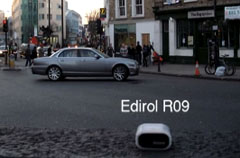 Sonorous City is an immersive surround-sound installation exploring the relationship between the soundscape and our perception of the urban environment. A series of soundwalks stemming from the River Thames form the basis of the work, which reveals an experience of London lead by the ear.
Sonorous City is an immersive surround-sound installation exploring the relationship between the soundscape and our perception of the urban environment. A series of soundwalks stemming from the River Thames form the basis of the work, which reveals an experience of London lead by the ear.
Biography: Since 2006 Zai has been exhibiting work in Singapore, London and most notably Venice; collaborating with artist Tang Da Wu in creating a multimedia sculptural installation at the Singapore Pavillion for the 52nd Venice Biennale (2007).
Zai’s site is at www.zaitang.com. You’ll see the (very nicely made) video he made about this project there.
Jan Meinema – Bath Spa University and Dan Blore – visual artist
Cymatics: Liquids and Sound
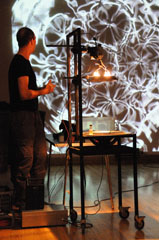 A presentation of the ongoing practical research of Dan Blore and Jan Meinema into capturing Cymatic sound sculptures using various liquids and bespoke made physical wave drivers. Combining the two to reveal unique natural shapes and patterns. Images from the sound sculptures are created in real time, and without the aid of computers. The practice is inspired by the work of Cymatics pioneer Dr Hans Jenny during the 50’s and 60’s. The recent research focus has been with revealing more detailed visualisations of harmonic content within the sound sources.
A presentation of the ongoing practical research of Dan Blore and Jan Meinema into capturing Cymatic sound sculptures using various liquids and bespoke made physical wave drivers. Combining the two to reveal unique natural shapes and patterns. Images from the sound sculptures are created in real time, and without the aid of computers. The practice is inspired by the work of Cymatics pioneer Dr Hans Jenny during the 50’s and 60’s. The recent research focus has been with revealing more detailed visualisations of harmonic content within the sound sources.
Jan and Dan’s powerpoint slides can be seen here, and more documentation on their research progress can be found at: www.cymatics.org
Biography: Dan Blore’s love of sound and visuals found its home at Peter Gabriels Realworld Studios in Wiltshire, as principal interactive artist on the multi-award winning audio-visual EVE cd-rom, and later with the BAFTA winning Ceremony of Innocence cd rom. Dan’s recent work includes the video design for Peter Gabriels ‘Growing Up Tour’ live show. His freelance work has also included film direction and post production.
Biography: Jan Meinema started as a studio engineer and music producer at NR Studios in Groningen Holland, experimenting with recording techniques, sound creation & manipulation. Additionally he has been working within various areas of interactive media and audio/visual practice. He completed an MA in Digital Media at UWE in Bristol. His current teaching practice includes leading an Audio Post Production for Moving Image module on the BA Hons degree in Creative Music Technology at Bath Spa University.
Stephen Callear – Bath Spa University
Audiovisual Particles: Mapping strategies for a perceptual correlation between visual particles and audio grains
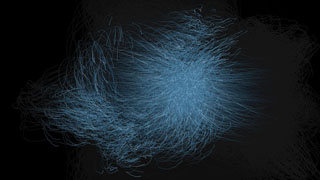 While it is rarely discussed explicitly, the concept of parameter mapping – the transposition of data from one medium to another – may arguably form a model for audiovisual composition. This paper seeks to define terminology relevant to parameter mapping within audiovisual composition and explores conceptual frameworks for the transposition of parameters between mediums. The concepts of mapping complexity and time scale are discussed and the objects /particle /and /cloud /are offered as conceptual structures relevant to audiovisual composition. Mapping strategies for the organisation of audio grains and visual particles are offered, and the relevance of behavioural simulation as a data set for the concurrent synthesis mediums is discussed.
While it is rarely discussed explicitly, the concept of parameter mapping – the transposition of data from one medium to another – may arguably form a model for audiovisual composition. This paper seeks to define terminology relevant to parameter mapping within audiovisual composition and explores conceptual frameworks for the transposition of parameters between mediums. The concepts of mapping complexity and time scale are discussed and the objects /particle /and /cloud /are offered as conceptual structures relevant to audiovisual composition. Mapping strategies for the organisation of audio grains and visual particles are offered, and the relevance of behavioural simulation as a data set for the concurrent synthesis mediums is discussed.
The full text of Stephen’s talk can be seen here, and his film ‘Cirrus’ here
Ilias Bergstrom – University College London
Harnessing the enactive knowledge of musicians to allow the real-time performance of correlated music and computer graphics.
 A presentation of a novel, entirely custom developed system, which allows the performance of live visual music to be controlled primarily using data generated from musical instruments. The motivation of this design is that, by connecting musical control data (notes, tempo, volume, etc) to graphical control data, the intuitive immediacy embodied knowledge affords musicians, may also be reflected in the resulting animation.
A presentation of a novel, entirely custom developed system, which allows the performance of live visual music to be controlled primarily using data generated from musical instruments. The motivation of this design is that, by connecting musical control data (notes, tempo, volume, etc) to graphical control data, the intuitive immediacy embodied knowledge affords musicians, may also be reflected in the resulting animation.
You can see a pdf of Ilias’ powerpoint slides here. Here are a couple of links to papers Ilias has written on his system, and here some video clips of the results.
Biography: Visual arts, music and technology have always competed for my attention, but never has one managed to distract me from the other for too long. From drawing and painting, I was soon compelled to create imagery using the computer. Gravitating towards generative, procedural imagery, my computer science studies taught me to implement my creative ideas in software. In parallel, from having played drums and keyboards, the composition possibilities afforded by computers intrigued me. My work has in the years leading up to my ongoing PhD studies, gravitated towards an integration of visual arts, music and technology. All the while, performance using embodied knowledge has never left center stage.
Dr David Reid – Nottingham Trent University
Engaging with Environment; New Perspectives on Practice and Perception in Landscape Representation
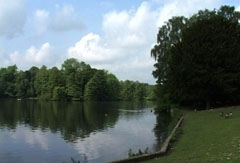 Landscape as presence or image has long been established as an aesthetic experience privileging visual form observed from a distant and static perspective. Recent developments in social anthropology and cultural geography propose a rethinking on landscape and of the centrality of the visual in landscape representation. Moving beyond a critique of ocularcentrism and using a model based on the reception of sound, Tim Ingold [2000/2008], proposes a rethinking of our encounter with light, sound, and environment which reconfigures perception and subjectivity such that an experience of landscape becomes immersive and dynamic rather than distant and static. In cultural geography questions of embodiment and practice have opened new research concerns to reevaluate relationships between ourselves and landscape, and to posit multifaceted relationships within living landscapes. Within art practice itself landscape representation has opened up to include forms such as environmental sound. These developments offer practitioners in the arts and the humanities an invitation to engage with environment rather than landscape and place ourselves within nature rather than outside it. This paper/presentation considers this invitation and its implications for visual practice in times of ecological change. By example, reference will be given to the presenter’s own practice, an ongoing work of visual and audio recordings using digital technology, set in an environment in which issues of the local and the global are at stake.
Landscape as presence or image has long been established as an aesthetic experience privileging visual form observed from a distant and static perspective. Recent developments in social anthropology and cultural geography propose a rethinking on landscape and of the centrality of the visual in landscape representation. Moving beyond a critique of ocularcentrism and using a model based on the reception of sound, Tim Ingold [2000/2008], proposes a rethinking of our encounter with light, sound, and environment which reconfigures perception and subjectivity such that an experience of landscape becomes immersive and dynamic rather than distant and static. In cultural geography questions of embodiment and practice have opened new research concerns to reevaluate relationships between ourselves and landscape, and to posit multifaceted relationships within living landscapes. Within art practice itself landscape representation has opened up to include forms such as environmental sound. These developments offer practitioners in the arts and the humanities an invitation to engage with environment rather than landscape and place ourselves within nature rather than outside it. This paper/presentation considers this invitation and its implications for visual practice in times of ecological change. By example, reference will be given to the presenter’s own practice, an ongoing work of visual and audio recordings using digital technology, set in an environment in which issues of the local and the global are at stake.
Biography: Since gaining a PhD in photographic practice and critical theory of film and photography in 2000, Dr David Reid, has taught critical theory and practice in the still and moving image at Nottingham Trent University, David is also a researcher and practitioner in sonic and visual art. Central to his research activity is the development of the project, Perspectives on Practice and Perception, a series of seminars and symposia bringing together participants from many disciplines for creative exchange on forms of practice. Within his own practice David currently follows two themes; recording musicians in performance; and, audio and visual recordings that engage with representations of environmental spaces. His work can be found on line at – www.insidespace.org.uk/MishMusic/MishMusic09.html
Dr Jaroslaw Kapuscinski – Stanford University
Point and Line to Intermedia
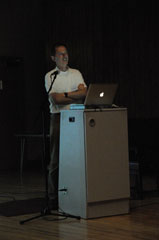 Many live multimedia works today use aural and visual material of impressive complexity. In my work, I am more drawn by simplicity. Inspired by Wassily Kandinsky’s “Point and line to plane”, in which the artist attempts to classify the expression of basic graphical material, I asked myself the questions: what are intermedia points and lines? How does one compose using basic intermedia elements? The paper discusses examples from two performance works: The Point Is… and Counterlines. The narrative of the first is made of collisions of projected visual points, musical gestures played on a piano and spoken word expressions. The second is a counterpoint of graphic and melodic lines performed by a duet: a pianist who generates graphic lines as he plays the piano, and a graphic performer who generates piano lines as he draws on a Wacom tablet.
Many live multimedia works today use aural and visual material of impressive complexity. In my work, I am more drawn by simplicity. Inspired by Wassily Kandinsky’s “Point and line to plane”, in which the artist attempts to classify the expression of basic graphical material, I asked myself the questions: what are intermedia points and lines? How does one compose using basic intermedia elements? The paper discusses examples from two performance works: The Point Is… and Counterlines. The narrative of the first is made of collisions of projected visual points, musical gestures played on a piano and spoken word expressions. The second is a counterpoint of graphic and melodic lines performed by a duet: a pianist who generates graphic lines as he plays the piano, and a graphic performer who generates piano lines as he draws on a Wacom tablet.
An mp4 movie of Jaroslaw’s presentation (including video clips) can be found here. He also has lots of other material at www.jaroslawkapuscinski.com
Biography: Jaroslaw Kapuscinsci is an intermedia composer and pianist whose work has been presented at New York’s MOMA, ZKM in Karlsruhe, Museums of Modern Art Palais de Tokyo and Centre Pompidou in Paris, National Reina Sofia Museum in Madrid and many other venues in Europe, Asia and the Americas. He has received awards at the UNESCO Film sur l’art Festival in Paris (1992), VideoArt Festival in Locarno (1993, 1994) and Festival of New Cinema and New Media in Montréal (2000). Kapuscinski graduated from Academy of Music in Warsaw and University of California, San Diego. Currently he teaches composition and intermedia at Stanford University.
Dr Tim Howle (University of Hull) – Making Electroacoustic Movies II
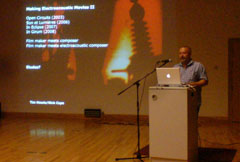 The paper attempts to rationalize what happens when acousmatic music and video is combined to create an integrated piece of art. The alignment of the acousmatic forces to the visual components must impinge upon the nature of the materials and the role of the creator(s).
The paper attempts to rationalize what happens when acousmatic music and video is combined to create an integrated piece of art. The alignment of the acousmatic forces to the visual components must impinge upon the nature of the materials and the role of the creator(s).
A pdf of Tim’s powerpoint slides can be seen here
Biography: Tim Howle currently lectures in Electroacoustic music at the University of Hull. Before this he was director of the Electronic Music Studios at Oxford Brookes University. He read music at Keele University, studying under Roger Marsh and Mike Vaughan completing a doctorate in composition in 1999. His work centres on electroacoustic music including pieces for tape, performer and live electronics and pieces involving visual media.
His work has been performed throughout the US, the EU and Asia.
Biography: Nick Cope currently works as Senior Lecturer in Video and New Media Production a the University of Sunderland. Graduated in 1986 from Sheffield Hallam University and worked freelance in film and video production with a particular emphasis on music and moving image work, collaborating with Cabaret Voltaire, the Butthole Surfers, O yuki Conjugate and Electribe 101 amongst others. More recent work has included projection work for public arts projects and installation collaborations.
Maura McDonnell – Trinity College Dublin
Visual Music – Integrated Composition
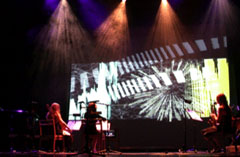 Approaching Visual Music as an integrated composition of aural and visual material has been for Maura McDonnell the basis of a way of thinking about visual music for both teaching and as the foundation for analysing what is this thing – Visual Music. The early abstract filmmaker Walter Ruttmann foresaw in 1919 that a “new, hitherto latent type of artist would emerge, approximately half-way between painting and music.” Indeed, today, there are indeed artists/musicians/composers who work with the medium of visual composition through video projection and sound/music composition to create combined integrated visual music works. Much of the work is done by individuals, who craft their aural and music material to create these works. The focus of this presentation is on drawing attention to one strand of visual music which is an activity of composition by one individual. A selection of extracts will be shown from visual music pieces that were created between 2002 to present by individual students attending the M. Phil in Music and Media Technology programme at Trinity College Dublin. The artists/composers are: Neil O’Connor, Amanda Feery, Fran Hartnett, Shane McKenna, Paul Smyth and Jane Cassidy.
Approaching Visual Music as an integrated composition of aural and visual material has been for Maura McDonnell the basis of a way of thinking about visual music for both teaching and as the foundation for analysing what is this thing – Visual Music. The early abstract filmmaker Walter Ruttmann foresaw in 1919 that a “new, hitherto latent type of artist would emerge, approximately half-way between painting and music.” Indeed, today, there are indeed artists/musicians/composers who work with the medium of visual composition through video projection and sound/music composition to create combined integrated visual music works. Much of the work is done by individuals, who craft their aural and music material to create these works. The focus of this presentation is on drawing attention to one strand of visual music which is an activity of composition by one individual. A selection of extracts will be shown from visual music pieces that were created between 2002 to present by individual students attending the M. Phil in Music and Media Technology programme at Trinity College Dublin. The artists/composers are: Neil O’Connor, Amanda Feery, Fran Hartnett, Shane McKenna, Paul Smyth and Jane Cassidy.
Maura has put up some great documentation of her presentation here
Biography: Maura McDonnell has several qualifications – a B.A in Music and Mathematics, H.Dip Ed., an M.Ed in Adult and Community Education and an M.Phi in Music and Media Technology. However, the most exciting part of her career has been the encountering of visual music. She has been part-time lecturing on the topic of visual music since 2002 as part of the music and image strand of the M.Phil in Music and Media Technologies programme, Trinity College, Dublin. A graduate of this course in 1998, an interest in visual music arose from her final year project on audio-visual composition. Asked to return as a lecturer in 2002 and teach on the music and image strand of the course, that interest developed into a more deeper investigation of both the historical origins of visual music and identify, uncover and encounter contemporary visual music work. For this purpose, she keeps a blog at http://visualmusic.blogspot.com